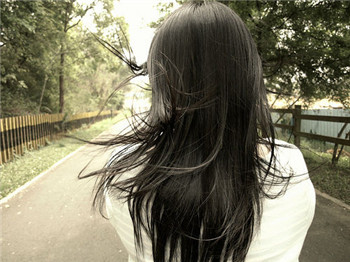
We’re a nation – a globe, in fact - obsessed with our hair. Analysts at Goldman Sachs estimate the global hair products industry to be worth $38bn (22.6bn) – and growing at a rate of up to seven per cent a year。
我们生活在一个对头发痴迷的时代。高盛集团的分析师估计全球的护发产品行业的总价值达380亿美元(约226亿英镑),并以每年7%的速度不断增长。
There seems to be no limit on what we’ll spend to avoid a bad hair day. But for devotees of an underground beauty movement, the secret lies in ditching the shampoo, in fact all the hair products, for good。
在这种情况下,我们想要拥有一头飘逸的秀发简直易如反掌。但是对地下爱美运动的支持者来说,护发的秘诀在于永远放弃使用诸如洗发水之类的任何护发产品。
The ‘no-poo’ method, which involves using natural substitutes or just water in place of shampoo and conditioner, has credibility within several circles。
“no poo”方法,意为用天然替代品或清水洗发来代替洗发水和护发素。这个方法得到很多人的支持。
Beauty insiders, including writers for women’s magazines and professional hairdressers, rave about how hair becomes thicker, fuller and more lustrous。
使用这种方法后,头发会变得更加厚实柔亮,包括女性杂志作家、专业美发师等在内的美容行家们对此都是赞不绝口。
And thrifty environmentalists rejoice at the lack of chemicals in and on their bodies - not to mention the impact on their budgets。
这种方法不仅能让洗发者从内到外远离化学物品,还省了不少钱。
Now one devotee is hoping to take it mainstream. Lucy Aitken Read, whose book Happy Hair: The definitive guide to giving up shampoo was released last week, hasn’t used shampoo in two years and her glowing auburn hair is visibly in perfect condition (see the photos if you don’t believe me)。
这项运动的一位支持者露西·瑞德希望能将这个活动主流化。她写了一本书名为《快乐头发:放弃使用洗发水的权威指南》,上周出版。露西已经有两年不使用洗发水了,但是她的一头栗色头发看起来状态相当好)(不信的话可以看图片)。
For her, the motivation came after reading a study that claimed women put 515 chemicals on their bodies daily. “I initially thought ‘Ha! They didn’t research me!’,” Aitken Read says. “Then I looked at the back of my shampoo bottle and realised there were loads of ingredients I didn’t recognise in the slightest。
露西开始有“不再使用洗发水”的想法是受到一篇研究的影响,这篇研究称女性每天用在自己身上的化学物质有515种之多。“我当时就想‘我可不是这样的’,露西说,‘然后我立刻查看我使用的洗发水瓶子上的成分说明,这才意识到原来里面包含了那么多我完全不懂的成分。’”
She does admit she was worried about the grease factor. “My hair used to get greasy the day after I washed it and I was addicted to dry shampoo. Hand on heart, I wasn’t sure how long I would last。”
露西承认刚开始的时候她很担心油腻问题。“我洗完头发第二天,头发就会变油,所以过去我很喜欢用干性洗发水。说实话,我并不确定这种状态会持续多久。”
Paradoxically it’s greasy hair that could benefit the most from giving up shampoo. The theory behind the ‘no-poo’ method is that shampoo strips the hair of its natural oils, which prompts the scalp to generate more oils to replace them. This results in oil overload – greasy hair – which we then attempt to ‘fix’ with more shampoo. It’s a vicious circle and quite a brilliant coup for the shampoo industry, because the more shampoo you use, the more you need to use and the more frequently you need to use it。
奇怪的是,放弃使用洗发水得到的最大的好处恰好就是一头油油的头发。“no poo”方法背后遵循的原理是,洗发水夺去了头发上的天然油脂,而这又促使头皮分泌更多新的天然油脂。结果就是头皮出油过多、头发变油腻,然后我们会用更多的洗发水来“修复”。这就像一个恶性循环,但这却造福了洗发水行业—你使用的洗发水越多,你买的量越大,买的次数越多。
Left to its own devices or washed with natural substitutes, the scalp eventually theoretically returns to its natural balance, producing enough oil to keep hair soft and smooth without the associated grease-slick. The oils produced by the scalp – notably sebum – keep the shaft of the hair clean, smooth and protected, performing the role of ‘shampoo and conditioner’ far more effectively than the manufactured alternatives. The upshot should be healthier hair that is stronger, thicker and fuller as it is less damaged than shampooed hair。
使用天然的洗发水替代品,然后把这些问题都留给头发自己去调节,理论上来说头皮最终将会达到一种平衡状态,在这种状态之下,头皮将会产生适量的油脂来维持头发软滑。头皮产生的油脂具有滋养发根,保护头发的功能,这些油脂虽然充当了洗发水的角色,但对人类的损伤却远小于人造洗发水,其结果就是你的头发将会变得更加健康强壮,充盈厚实。
Most ‘no-pooers’ use alternatives to shampoo and Aitken Read’s book contains 30 different shampoo, conditioner and styling alternatives. Put together, they read like a cake recipe – bicarbonate of soda, flour, egg, honey, lemon juice. But after a period of time most find just plain old water does the job fine. “I use water on my hair every three to four days, and every 10 to 14 days I might use an egg on it, or some bicarbonate of soda,” Aitken Read explains。
许多不用洗发水的人都会使用洗发水的替代品,所以露西的书中介绍了30种洗发水、护发素、造型用品等的替代品。这些替代品包括小苏打、面粉、鸡蛋、蜂蜜、柠檬汁等,看起来就像是一份蛋糕配方。但是一段时间以后发现只是普通的自来水就很有用。“我每三四天用清水洗一次头发,每10到14天用一次鸡蛋或一些小苏打。”露西说。
“Last night somebody on Twitter saw a link to my book and tweeted saying four people in her office were doing it. It’s gone crazy。”
“昨天晚上还有人在推特上看到我新书的链接,然后发推特告诉我说她们办公室里已经有4个人开始尝试这种方法了,根本停不下来。”
Tempted to go ‘no-poo’? Here’s your essential checklist:
如果你也想尝试“no poo”的方法,下面是几条基本的建议。
1. Bicarbonate of soda. The traditional alternative to shampoo, cleans the scalp without stripping it of natural oils。
1.小苏打。传统的洗发水替代品,可以在不夺去天然油脂的同时清洁头皮。
2. Apple cider vinegar. A popular alternative to conditioner, which works with the bicarbonate to restore the natural pH of the hair。
2.苹果醋。非常受欢迎的护发素替代品,和小苏打一起作用可以使头发恢复到原本的PH值。
3. A bristle brush. Bristles stimulate the scalp and distribute sebum all the way down the hair shaft。
3.一根毛刷。可以刺激头皮,而且还能头皮上的皮脂顺着头发梳下来。
4. A hat or headscarf - for when it all gets too much。
4.帽子或头巾。可以用在头发太多的时候。
5. Willpower. Brace yourself for a few difficult weeks – Aitken Read has heard of it taking up to three months for particularly difficult hair types to adjust – and keep your eye on the prize of healthy, glossy, lustrous hair with zero effort。
5.毅力。做好要度过几周难关的准备。露西曾听说,发质不是特别好的人要花三个月来适应这个过程。只要有毅力,就一定能拥有健康、柔顺、有光泽的头发。












